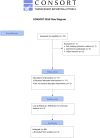A tele-health primary care rehabilitation program improves self-perceived exertion in COVID-19 survivors experiencing Post-COVID fatigue and dyspnea: A quasi-experimental study
- PMID: 35926004
- PMCID: PMC9352012
- DOI: 10.1371/journal.pone.0271802
A tele-health primary care rehabilitation program improves self-perceived exertion in COVID-19 survivors experiencing Post-COVID fatigue and dyspnea: A quasi-experimental study
Abstract
Background: Current evidence suggests that up to 70% of COVID-19 survivors develop post-COVID symptoms during the following months after infection. Fatigue and dyspnea seem to be the most prevalent post-COVID symptoms.
Objective: To analyze whether a tele-rehabilitation exercise program is able to improve self-perceived physical exertion in patients with post-COVID fatigue and dyspnea.
Methods: Sixty-eight COVID-19 survivors exhibiting post-COVID fatigue and dyspnea derived to four Primary Health Care centers located in Madrid were enrolled in this quasi-experimental study. A tele-rehabilitation program based on patient education, physical activity, airway clearing, and breathing exercise interventions was structured on eighteen sessions (3 sessions/week). Self-perceived physical exertion during daily living activities, dyspnea severity, health-related quality of life and distance walked and changes in oxygen saturation and heart rate during the 6-Minute walking test were assessed at baseline, after the program and at 1- and 3-months follow-up periods.
Results: Daily living activities, dyspnea severity and quality of life improved significantly at all follow-ups (p<0.001). Additionally, a significant increase in oxygen saturation before and after the 6-Minute Walking test was found when compared with baseline (P<0.001). Heart rate adaptations at rest were found during the follow-up periods (P = 0.012). Lower perceived exertion before and after the 6-Minute Walking test were also observed, even if larger distance were walked (P<0.001).
Conclusion: Tele-rehabilitation programs could be an effective strategy to reduce post-COVID fatigue and dyspnea in COVID-19 survivors. In addition, it could also reduce the economic burden of acute COVID-19, reaching a greater number of patients and releasing Intensive Unit Care beds for prioritized patients with a severe disease.
Study registration: The international OSF Registry registration link is https://doi.org/10.17605/OSF.IO/T8SYB.
Conflict of interest statement
The authors have declared that no competing interests exist.
References
-
- World Health Organization. COVID-19 Dashboard, 2022. Available at: https://covid19.who.int.
-
- Fernández-de-las-Peñas C, Palacios-Ceña D, Gómez-Mayordomo V, Cuadrado ML, Florencio LL. Defining Post-COVID Symptoms (Post-Acute COVID, Long COVID, Persistent Post-COVID): An Integrative Classification. Int J Environ Res Public Health. 2021;18(5):2621. doi: 10.3390/ijerph18052621 - DOI - PMC - PubMed
Publication types
MeSH terms
LinkOut - more resources
Full Text Sources
Medical


